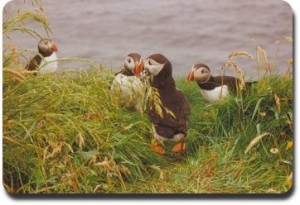
Puffins
The report uses data collected by volunteers and professionals from a sample of breeding colonies around Scotland. It shows that, from 1986 to 2011, the numbers of seabirds breeding in Scotland has dropped by around 53%.
Of the 11 species reviewed over the 25-year period, the numbers of nine decreased. The largest declines were for the Arctic skua (74%), Arctic tern (72%) and black-legged kittiwake (66%). Two seabirds have remained stable (black guillemot and northern fulmar).
The continuing decreases have been linked to a range of factors such as food shortages, weather conditions and predation by non-native species such as brown rats and mink. The number of small shoaling fish, which are an important food source for many seabirds, may have fallen. These fish are probably being affected by rising sea temperatures because of climate change, as well as other factors.
A range of measures has been put in place to help combat pressures on the seabirds. Voluntary reductions in sandeel fisheries means that very little if any sandeel fishing now takes place within the foraging range of kittiwakes, a species which has seen a particularly sharp drop in numbers in recent years. The control of non-native predators, such as the brown rat and the American mink, has also been carried out on various parts of the Scottish coastline and islands and is now starting to show some benefits, with terns re-colonising some areas. The Scottish Government’s Marine Bill also includes measures to improve marine nature conservation to safeguard and protect Scotland’s unique habitats.
Susan Davies, SNH’s Director of Policy & Advice, said: “These results aren’t surprising, as they echo results from recent years. Thanks to the huge effort from volunteers and professionals, we’re now able to monitor seabird numbers much more effectively than in the past. The results give even more impetus to continue the actions already in place to improve the situation for seabirds. It’s vital that we continue to monitor the state of Scotland’s seabirds and the marine environment and to use this information to guide future actions.”
Scotland’s seabirds are internationally important with around four million breeding seabirds of 24 species. The recent drop in numbers follows two decades of occasional years of poor breeding – but poor years have happened more often and with more severity since 2000.
This SNH report was prepared using data from the Seabird Monitoring Programme. The Seabird Monitoring Programme is a partnership project, led and co-ordinated by the Joint Nature Conservation Committee (JNCC) and involving a range of conservation partners.
